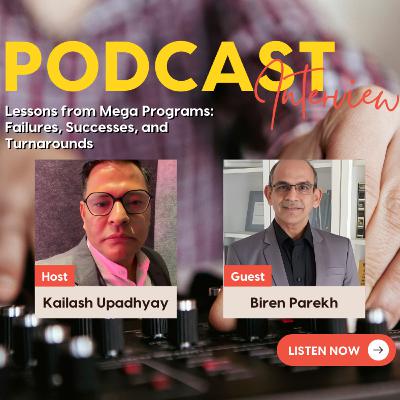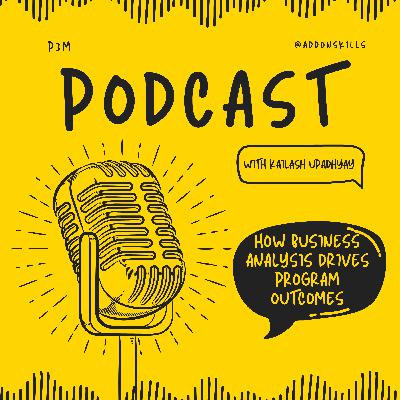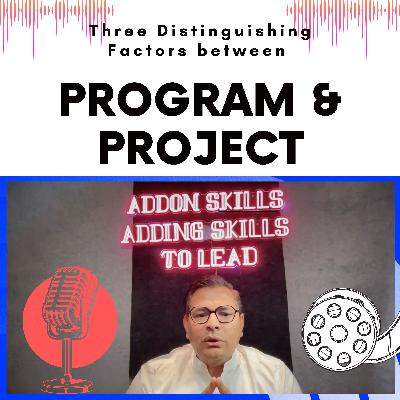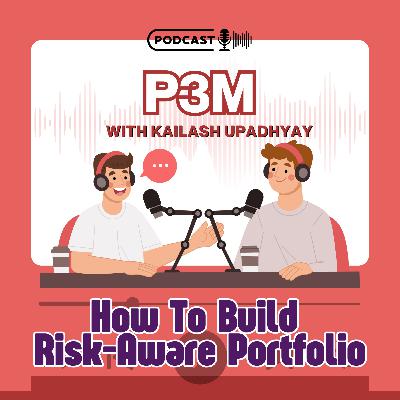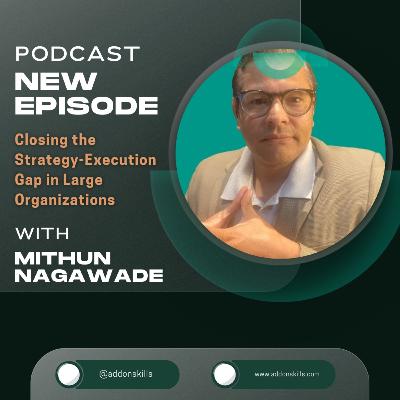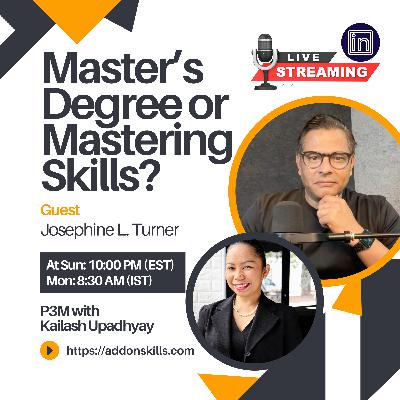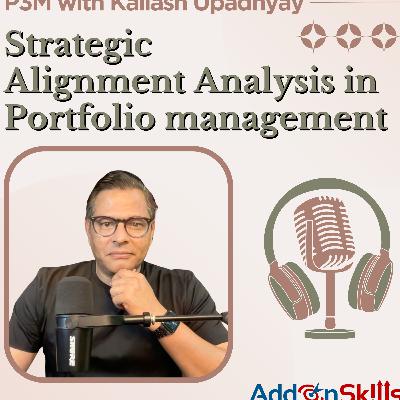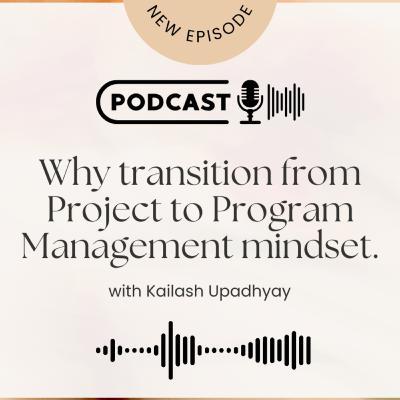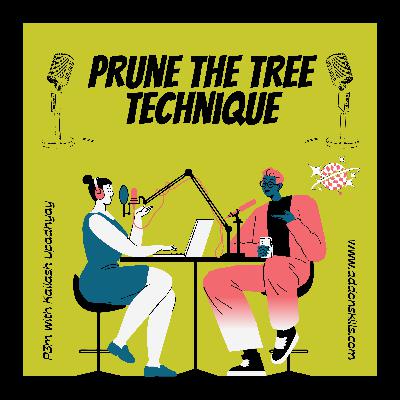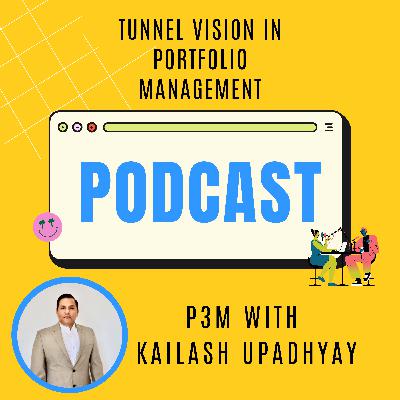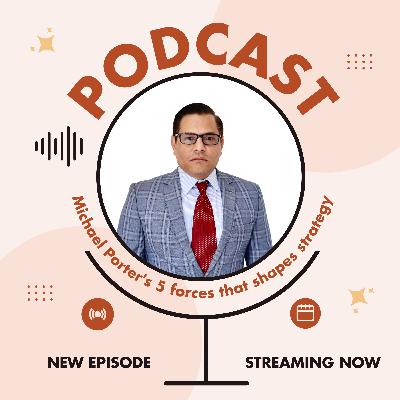Discover P3M with Kailash Upadhyay
P3M with Kailash Upadhyay

P3M with Kailash Upadhyay
Author: Kailash Upadhyay
Subscribed: 2Played: 32Subscribe
Share
© Kailash Upadhyay
Description
Welcome to P3M, the ultimate podcast show that takes you on an exciting journey into the world of project, program, and portfolio management. In this show, we explore the fundamental principles, best practices, and success stories that make P3M a critical discipline in today's dynamic business environment. Whether you're an aspiring project/Program/Portfolio manager, a seasoned professional, or simply curious about the field, P3M is here to inform, inspire, and elevate your understanding of this fascinating domain.
My LinkedIn profile to connect
https://www.linkedin.com/in/kailashupadhyay/
My LinkedIn profile to connect
https://www.linkedin.com/in/kailashupadhyay/
35 Episodes
Reverse
In this episode, we explore mega programs—large-scale, high-impact initiatives that shape industries, economies, and societies. Some succeed brilliantly, while others face catastrophic failures. What makes the difference? How can leaders navigate complexity and ensure success?Joining us is Biren Parekh, a globally recognized expert in program and project management. Together, we discuss:✅ What makes mega programs unique and different from traditional projects & programs?✅ The biggest reasons mega programs fail—and how to prevent them.✅ Mega program success stories and key lessons from them.✅ Turnaround strategies for failing mega programs.✅ Essential takeaways for PMP, PgMP, and PfMP professionals managing large-scale initiatives.Whether you're a project manager, program leader, portfolio executive, or P3M enthusiast, this episode will equip you with valuable insights to elevate your career and leadership skills.📢 Looking to achieve PMP, PgMP, or PfMP certification?We provide expert-led training and mentoring to help you succeed! Reach out today:🌐 Website: www.addonskills.com📧 Email: info@addonskills.com📞 Call/WhatsApp: +91 787-556-1193👉 Subscribe, rate, and share this episode with your network! Stay tuned for more insights on Project, Program, and Portfolio Management.🔗 Follow us on:📺 YouTube: https://www.youtube.com/playlist?list=PLiV7tmLdd8c9qeC14ObyH6WDAQmdHjXe4🎧 Spotify: https://open.spotify.com/show/2ncT7WLvFCO9dUeawQr6CB?si=c08f444dd3fc444c🍏 Apple Podcasts: https://podcasts.apple.com/in/podcast/p3m-with-kailash-upadhyay/id1677731267#P3M #P3mwithKailashUpadhyay #MegaPrograms #ProgramManagement #ProjectManagement #PMP #PgMP #PfMP #TurnaroundStrategies #PortfolioManagement #LessonsLearned #Leadership #Podcast #KailashUpadhyay #AddonSkills #addingskillstolead
In this episode of P3M, Kailash Upadhyay and Rami Kaibni discuss the critical role of business analysis in program management. They explore how business analysis aligns program outcomes with organizational strategy, the importance of mapping business analysis knowledge areas to the program lifecycle, and the challenges faced when business analysis is lacking. Rami shares insights on developing business analysis capabilities and the evolving role of business analysis in the context of emerging trends like digital transformation and data analytics.Takeaways:1. Business analysis skills are essential for program managers.2. Aligning program outcomes with organizational strategy is crucial.3. Business analysis is a competency required at all management levels.4. Elicitation and collaboration are key throughout the program lifecycle.5. Challenges arise when business analysis is missing from program management.6. Developing business analysis capabilities requires both knowledge and experience.7. Understanding the importance of traceability in business analysis is vital.8. Data analytics will play a significant role in future program management.9. Professional development is essential for program managers.10. The best program managers continuously learn and adapt.Chapters: 00:00 Introduction to Business Analysis in Program Management08:07 Mapping Business Analysis Knowledge Areas to Program Lifecycle13:03 Challenges of Missing Business Analysis in Program Management17:49 Developing Business Analysis Capability for Program Managers18:51 The Importance of Experience Over Certification21:14 Business Analysis Techniques: A Tailored Approach27:33 Core Competencies in Business Analysis31:34 Navigating Challenges During Uncertain Times35:28 The Evolving Role of Business Analysis in Digital Transformation37:41 Final Insights for Aspiring Program Managers✅ If you're a PgMP aspirant and want to pass on your first attempt with above-target scores, register now using the link below. For any queries, WhatsApp us at (+91) 787-556-1193.https://www.addonskills.com/course/project-management/pgmp-certification-training📘 Grab your copy of *"Excelling Program Management – A PMI-PgMP Study Companion"* on Amazon using the link below! Amazon INDIA: https://amzn.in/d/5OmOaEXAmazon USA: https://a.co/d/59O28M0
In this podcast episode, Kailash Upadhyay explores the distinctions between projects and programs, emphasizing the importance of understanding tactical and strategic changes. He discusses how projects drive tactical changes while programs focus on strategic changes that maximize benefits for customers. The conversation also delves into the concepts of uncertainty and complexity in project and program management, highlighting the increased risks and challenges faced at the program level. Through examples and insights, Kailash provides a comprehensive understanding of these critical management concepts.📌 Key Takeaways from the session:🎯 Projects drive tactical change, while programs drive strategic change.🔄 Tactical change focuses on existing benefits, whereas strategic change aims to maximize new benefits.🔍 Understanding the difference between project and program is crucial for effective management.🌪️ Uncertainty is higher at the program level due to multiple components and interdependencies.🎯 Program scope is about why we deliver products, focusing on benefits realization.⚠️ Proactive risk identification is essential for successful program management.🧩 Complexity increases at the program level due to stakeholder involvement and changing product scope.🚀 A program manager's role is vital in delivering benefits aligned with organizational goals.💬 Customer feedback is crucial in determining the need for strategic changes.🌟 Effective program management requires a clear understanding of change dynamics.💡 What are your thoughts? Have you encountered challenges in distinguishing projects from programs? Drop your comments below! 👇🚀 Aspiring PMP, PgMP, PfMP, or PMI-RMP certified professional?At Addon Skills®, we provide expert-led training to help you achieve your certification goals. Visit www.addonskills.comor WhatsApp us at (+91) 797-556-1193 to take the next step in your professional growth.#ProgramManagement #PgMP #ProjectManagement #PMI #Leadership #P3M #AddonSkills #P3MwithKailashUpadhyay #addingskillstolead #PgMPtraining #PgMPCertification
SummaryIn this podcast episode, Kailash Upadhyay and Thomas Walenta discuss the challenges of managing portfolios in a chaotic environment. They explore the inevitability of disruption in today's business landscape and the importance of effective portfolio management. The conversation covers common disruptions, the significance of strategy and communication, frameworks for regaining control, cultural aspects, real-world examples of chaos, the role of leadership, and future trends in portfolio management. Thomas emphasizes the need for emotional intelligence and resilience in navigating these challenges, while also highlighting the value of diversity and proactive approaches in managing chaos.Takeaways:Destruction is inevitable in today's volatile environment.Every organization is doing portfolio management, whether they know it or not.Management changes direction leads to burnout and attrition.You can't stop everything if you don't handle this.Stay proactive and extend your network.Emotional intelligence is key to effective leadership.Chaos is not bad; enjoy chaos because without it, there is no life.Value is perceived differently by different stakeholders.Cultural awareness is crucial in managing teams.Resilience is about how to respond to chaos effectively.Chapters:00:00 From Chaos to Control: An Introduction02:15 Understanding Disruptions in Portfolio Management24:15 Frameworks for Realigning and Controlling Portfolios38:37 Cultural Perspectives on Problem-Solving43:03 Real-World Examples of Chaos in Banking47:26 Technology as a Disruptor in Organizations50:17 The Importance of Governance in Managing Chaos57:11 Leadership and Team Dynamics in Disruption Management01:01:13 Emotional Intelligence vs. Artificial Intelligence01:03:55 Future Trends in Portfolio Management01:10:36 Actionable Advice for Navigating Disruption01:14:24 educational-intro-high-short.wavStay Connected with the P3M CommunityIf you enjoyed this episode, please follow, like, and share it to add value to the P3M community. Your support helps us reach more professionals and share critical insights on portfolio, program, and project management.For more information on P3M certification, including PMP, PgMP, and PfMP certifications, visit our website athttps://www.addonskills.comHave questions or need more details? Feel free to reach out on WhatsApp at (+91) 982-084-5035.Let's connect on LinkedIn for more updates and professional insights: https://www.linkedin.com/in/kailashupadhyayThank you for being a part of the P3M community. Together, we can turn chaos into control!
In this podcast episode, I and Gaurav Dhooper
discuss the critical importance of building a risk-aware portfolio that aligns with organizational strategic goals. They explore the integration of risk management into strategy, the key steps to create a risk-aware culture, and share real-world examples and practical tips for effective risk management. The conversation emphasizes the need for stakeholder engagement, data-driven decision-making, and continuous monitoring to ensure successful portfolio
management.
Takeaways
• Risk management is essential for achieving strategic goals.
• Strategy and risk management are interconnected.
• Everyone in the organization has a role in managing risk.
• Data-driven decision-making enhances risk management effectiveness.
• Building a risk-aware culture is crucial for success.
• Integrating risk management into governance is necessary.
• Data quality impacts risk management outcomes.
• Understanding risks is vital for strategic planning.
• Engaging stakeholders improves risk management processes.
• Breaking down risks into smaller parts facilitates better management.
Chapters
00:00 Introduction to Risk-Aware Portfolio Management
08:02 Building a Risk-Aware Portfolio
31:50 Aligning Risk Management with Strategic Direction
32:24 Understanding Risk Management Components
33:30 Integrating Risk Management with Strategy
35:07 The Role of Governance in Risk Management
40:17 Real-World Examples of Risk Management
46:50 Practical Tips for Effective Risk Management
For PMP, PgMP, PfMP, RMP certification training program, visit us at https://www.addonskills.com or WhatsApp at (+91) 787-556-1193.
In this podcast episode, I and Dr. Sriram Rajagopalan discuss the implementation of agile practices in portfolio management. We explore the benefits of agility, the challenges organizations face in adopting these practices, and the importance of a cultural shift towards collaboration and continuous improvement. The conversation emphasizes the need for strategic alignment, customer collaboration, and the significance of context in portfolio management. Real-world case studies illustrate the successful application of agile principles, highlighting the transformative impact on organizational performance.
Takeaways:
1. Agility in portfolio management focuses on ongoing strategic alignment.
2. Responding to change is more important than following a rigid plan.
3. Cultural resistance is a significant challenge in implementing agile practices.
4. Customer collaboration is essential for successful portfolio management.
5. Simplicity in processes can lead to better outcomes in portfolio management.
6. Regular reflection and retrospection can enhance team effectiveness.
7. Empowering teams leads to better decision-making and innovation.
8. Contextual understanding is crucial for effective portfolio management.
9. Leadership plays a vital role in fostering an agile culture.
10. Continuous improvement is key to maintaining competitive advantage.
Chapters
00:00 Introduction to Agile in Portfolio Management
02:50 Understanding Agile Practices at Portfolio Level
13:09 Benefits of Agile in Portfolio Management
33:06 Challenges in Transitioning to Agile Portfolio Management
38:45 Unlearning and Agility
39:09 Leadership and Competency Gaps
40:44 Transformational Leadership Principles
41:13 Cultural and Funding Challenges
42:23 Business-Centric Metrics
43:44 Value Addition in Training
44:24 Impact of Training on Careers
46:28 Contextual Understanding in Agile
51:09 Best Practices for Agile Portfolio Management
55:11 Self-Organizing Teams and Leadership
01:05:15 Case Study: Whirlpool's Agile Transformation
If you want to achieve PMP, PgMP, or PfMP certification, visit our website https://addonskills.com or contact us at (+91) 787-556-1193.
In today’s dynamic business environment, the strategy-execution gap is one of the most critical challenges organizations face. Despite robust strategies, many fail to deliver tangible outcomes due to misalignment, governance barriers, and cultural resistance.
In this episode of P3M with Kailash Upadhyay, I dive deep into this topic with Dr. Mithun Nagawade, a seasoned expert in strategic transformation. Together, we uncover actionable insights to help organizations bridge this gap effectively and thrive in the face of change.
What You’ll Learn in This Episode:
🔹 Understanding the Gap: Why large organizations struggle to translate strategy into results.
🔹 Root Causes: From siloed operations to inflexible governance and cultural barriers.
🔹 Bridging the Gap: Proven strategies for aligning goals, embracing agile governance, and investing in people.
🔹 Role of Technology: How tools, AI, and digital twins are reshaping execution frameworks.
🔹 Leadership’s Impact: Key qualities leaders need to inspire, align, and deliver results.
💡 Key Takeaways:
1️⃣ Align strategy with execution at every level.
2️⃣ Leverage technology to enhance visibility and decision-making.
3️⃣ Cultivate leadership and culture as the foundation for execution excellence.
🎧 Don’t miss this insightful conversation! Listen now to uncover the secrets of bridging the strategy-execution gap and driving success in your organization.
👉 Connect with Dr. Mithun Nagawade: / dr-mithun-mel-nagawade-phd-4bbb45b
📢 Follow the Podcast: Subscribe, leave a review, and share with your network!
In this episode, host "Kailash Upadhyay" and guest "Kareem Streek" delve into the often-overlooked topic of organizational politics in portfolio management. They discuss how politics can be both beneficial and detrimental, emphasizing the importance of transparency, ethical considerations, and cultural sensitivity. The conversation explores frameworks for navigating political landscapes, managing conflicting priorities, and the necessity of building alliances within organizations. Kareem shares practical tips for portfolio managers, highlighting the significance of data-driven decisions and effective communication in mitigating political struggles. The episode concludes with a focus on the ethical dimensions of organizational politics and the need for integrity in decision-making.
Takeaways
Organizational politics can have both positive and negative impacts.
Transparency and fairness are essential in navigating politics.
Cultural sensitivity is crucial in multinational environments.
Building alliances can enhance portfolio success.
Data-driven decisions help reduce the influence of politics.
Understanding stakeholder motivations is key to effective management.
Ethics should guide all political actions within organizations.
Effective communication is vital for managing conflicting priorities.
Frameworks like ONA can help understand informal networks.
Navigating politics requires strong leadership and soft skills.
Chapters
00:00 Introduction to Organizational Politics in Portfolio Management
01:55 Understanding Organizational Politics
06:01 Positive and Negative Influences of Politics
09:49 Navigating Conflicting Priorities
16:04 Frameworks for Managing Political Landscapes
22:41 The Importance of Context in Portfolio Management
24:01 Navigating Multinational Environments
26:47 Building Alliances and Cultural Sensitivity
28:35 Data-Driven Decisions vs. Organizational Politics
30:56 Cross-Functional Relationships and Synergy
34:43 Ethical Considerations in Organizational Politics
43:27 Final Thoughts on Navigating Politics in Portfolio Management
Do you have ideas for what our next podcast topic should be? I’d love to hear from you! Whether it's a deep dive into a specific P3M challenge, a case study, or emerging trends in project, program, or portfolio management, your suggestions are invaluable.
Also, if you’re an expert in the P3M domain and want to share your experience with our listeners, I’d be thrilled to feature you as a guest on the show. Let’s collaborate to inspire and empower professionals worldwide. Just drop me a message at kailash@addonskills.com
Moreover, If you have any queries related to PMP, PgMP, or PfMP certifications, then please Feel free to reach out directly:
📧 Email: support@addonskills.com📱 WhatsApp: +91-787-556-1193
Let’s make your certification journey smooth and successful.
In this episode, Kailash Upadhyay and Dr. S. Chandramouli discuss the critical importance of strategic alignment in portfolio management. They explore the challenges organizations face in aligning their portfolios with strategic goals, emphasizing the need for executive buy-in and effective communication. The conversation also contrasts traditional and modern approaches to strategic alignment, highlighting the shift towards value management and the use of OKRs. Best practices for maintaining alignment are shared, including the importance of governance and benefit realization plans. The discussion concludes with insights on the agility of smaller organizations and the necessity for regular evaluation of alignment practices.
Takeaways:
Strategic alignment is essential for organizational success.
Frequent changes in the business environment challenge alignment.
Executive buy-in is crucial for effective portfolio management.
Value management is becoming a key focus in strategic alignment.
OKRs help connect organizational objectives with key results.
Innovation should be integrated into project management.
Regular governance meetings enhance alignment and communication.
Organizations need to implement benefit realization plans.
Smaller organizations often take more risks and adapt quickly.
Alignment should be evaluated regularly, ideally quarterly.
Chapters:
00:00 Introduction to Strategic Alignment
04:11 Understanding Strategic Alignment Challenges
14:28 The Role of Executive Buy-In and Resources
20:02 Traditional vs. Modern Strategic Alignment Practices
35:07 Implementing OKRs and KPIs with Technology
37:41 Best Practices in Strategic Alignment
40:33 Continuous Alignment and Management by Objectives
45:35 Governance and Systems in Portfolio Management
47:47 Value Realization and Benefit Management
52:33 Aligning Portfolios with Multiple Objectives
54:53 Frequency of Portfolio Alignment
59:10 Risk Management in Smaller Organizations
01:03:25 educational-intro-high-long.wav
Your support fuels community growth! 🎯 Like, Share, and Comment to spread knowledge
and inspire professional development within the P3M community.
Let’s keep learning, growing, and leading
together! 🚀
For any certification such as PMP, PgMP
or PfMP related information visit https://www.addonskills.com or WhatsApp at
(+91) 787-556-1193.
The eternal question for P3M professionals:
Should you invest in a Master’s Degree or focus on Mastering Practical Skills?
We’ve all faced this dilemma at some point in our careers, and it’s time to get some clarity!
Join us in this engaging live discussion, where our expert guest Josephine Turner, a renowned leader in the P3M domain, will break down the pros and cons and help clear your mindset around this thought-provoking topic.
Don't miss this opportunity to learn from the best and find the answer to a question that has been the subject of countless debates in the P3M community.
If you are looking for personalized advisory based on your past, and current work experience as well as future goals in mind then book our advisory service, trust your investment in this will give you long terms returns.
https://www.addonskills.com/product/8...
As organizations strive to achieve strategic goals and maximize value, one often overlooked yet vital resource is Intellectual Capital—the combined power of knowledge, skills, expertise and relationships.📌
In my this video, I dive into:
1. What Intellectual Capital really means in a P3M context.
2. How it empowers portfolio management through strategic decision-making, innovation, and resource optimization.
3. Why nurturing human, structural, and relational capital is critical for staying competitive and agile in today’s dynamic business environment.
💼 Whether it’s leveraging team expertise, refining processes, or strengthening stakeholder relationships, intellectual capital is the backbone of portfolio success.
Your turn: How does your organization harness intellectual capital to drive success? Do you see untapped potential in this area? Share your thoughts in the comments—I’d love to hear your perspective!
🔥 Agenda Highlights:
✅ What is Strategic Alignment Analysis?
✅ Why Strategic Alignment Analysis?
✅ When and How Frequently to Perform Strategic Alignment Analysis?
✅ How to Perform Strategic Alignment Analysis?
✅ Techniques in Focus:
Dive into powerful methods like Kurt Lewin’s Force Field Analysis, Gap Analysis, and Readiness Analysis to make informed portfolio decisions.
✅ Who Should Be Involved?
👉 What’s Next?
Join the conversation! Share your ❤️ likes and 💬 feedback comments. What resonates with you about Strategic Alignment Analysis? What challenges have you faced in aligning portfolios with strategy?
🌟 Join Our PfMP Certification Training! 🌍
Dive deeper into Strategic Alignment Analysis and other advanced topics with global participants!
✅ Gain expert insights, practical techniques, and diverse perspectives.
✅ Achieve the prestigious PMI-PfMP Certification.
🚀 Transform your portfolio management skills and career!
📩 Comment or DM for details. Let’s make your PfMP dream a reality!
For Project Management Practitioner, this podcast explains the importance of transitioning from a project to a program management mindset in handling complex, large-scale initiatives. It emphasizes the need for a holistic view, strategic alignment, and effective governance to ensure the successful delivery of overarching organizational objectives.
The "Prune the Tree" technique is a concept derived from the agile principle of simplicity. It emphasizes the idea of continuously refining and simplifying project requirements and processes to achieve better outcomes. Just as a tree needs pruning to maintain its health and shape, projects benefit from regular review and elimination of unnecessary complexity.
The Balanced Scorecard can be a valuable tool in portfolio management as it provides a framework for aligning projects and programs with the organization's strategic objectives. By incorporating the Balanced Scorecard perspectives into portfolio management, organizations can ensure that the portfolio's composition reflects a balanced set of initiatives across various dimensions.
Tunnel vision is a real concern in portfolio management, but with awareness and proactive measures, it can be overcome. By staying informed, embracing diversification, seeking different opinions, and regularly reviewing your portfolio, you can mitigate the risks and make more well-informed investment decisions.
To learn portfolio management and become PMI-PfMP certified, join my upcoming portfolio management professional (PfMP) certification training. Reach out to us at support@addonskills.com or WhatsApp at (+91) 787-556-1193.
To connect with me on LinkedIn, click here.
In this podcast I have shared my experience with project risk management. Over a period of time after managing hundreds of projects, I have realize by not taking risks actually I am taking more risks in my projects. So listen to this podcast I am sure this will change your perspective about project risks management.
Please do follow my show P3M on whatever platform you listening to it, do share your feedback so I can further improve and add more value for you and larger community.
For any queries on Project Management (PMP) certification do write to us at support@addonskills.com or contact my team on WhatsApp at (+91) 787-556-1193.
The five program management performance domains - program strategy alignment, program benefits management, program stakeholder engagement, program governance, and program life cycle management - are interconnected and operate concurrently to ensure the success of a program. They rely on each other for information, inputs, and decision-making, demonstrating their interdependency in managing complex programs.
If you want to learn program and and are looking for PgMP training services then do reach out to us for more information at support@addonskills.com or WhatsApp at (+91) 787-556-1193. We are PMI authorized training partner (ATP) and out ATP ID is 4654. You can find our ATP status on PMI website.
We have helped highest no. of global professionals to achieve these global credential. Please visit below link to find these alumni success stories.
https://www.linkedin.com/feed/hashtag/?keywords=addonskillssuccessstories
The importance of Porter's Five Forces model in strategy management lies in its ability to provide a systematic framework for analyzing industry dynamics and formulating effective strategies. By understanding the forces at play, organizations can:
Identify competitive threats and opportunities: The model helps identify potential threats from new entrants, suppliers, buyers, or substitute products, allowing companies to proactively respond and develop strategies to mitigate risks or capitalize on opportunities.
Assess industry attractiveness: By evaluating the five forces, organizations can assess the overall attractiveness of their industry. Industries with low barriers to entry, high supplier power, and intense rivalry may be less attractive, while those with high entry barriers, low supplier power, and limited rivalry may offer more favorable conditions.
Develop competitive strategies: The insights gained from the Five Forces analysis can inform the development of competitive strategies. Companies can use the model to identify areas where they have a competitive advantage or to identify opportunities for differentiation, cost reduction, or strategic alliances.
Allocate resources effectively: The model helps organizations allocate their resources efficiently by focusing on areas of the business that are most affected by the competitive forces. It enables companies to prioritize investments, optimize their supply chain, and align their activities with the most significant factors influencing their industry.
Overall, Michael Porter's Five Forces model provides a structured approach to understanding industry competition and is a valuable tool for strategy management, enabling companies to make informed decisions and develop effective strategies to achieve a sustainable competitive advantage.
If you wants to learn this framework in depth then come and join me in my upcoming Portfolio Management Professional (PfMP) certification training. You can reach out to Addon Skills team at support@addonskills.com or WhatsApp at (+91) 787-556-1193 for more information about our PfMP certification courses.
I hope you are enjoying these podcast episode, do follow my show and share your feedback with us.
This is a very common question global professional asks, they are sometime confused between Project role and Program role. So watch this video for answer to this question.
If you want to learn project, program and portfolio management or looking for PMP, PgMP or PfMP training services then do reach out to us for more information at support@addonskills.com or WhatsApp at (+91) 787-556-1193. We are PMI authorized training partner (ATP) and out ATP ID is 4654. You can find our ATP status on PMI website.
We have helped highest no. of global professionals to achieve these global credential. Please visit below link to find these alumni success stories.
https://www.linkedin.com/feed/hashtag/?keywords=addonskillssuccessstories


